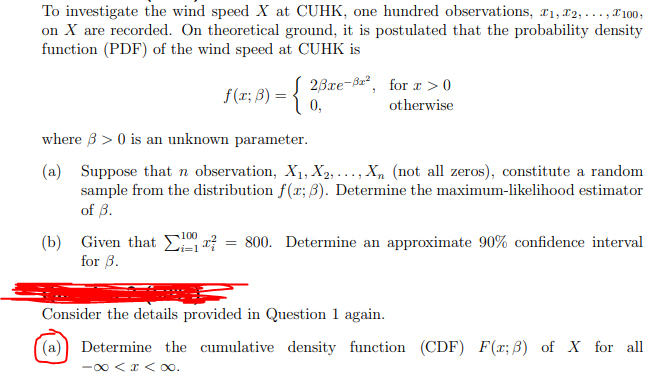To investigate the wind speed X at CUHK, one hundred observations, #1, x2, ..., ¤100, on X are recorded. On theoretical ground, it is postulated that the probability density function (PDF) of the wind speed at CUHK is f(r; 3) = { 23ze-ße", for æ > 0 0, otherwise where B > 0 is an unknown parameter. (a) Suppose that n observation, X1, X2, ..., X, (not all zeros), constitute a random sample from the distribution f(x; B). Determine the maximum-likelihood estimator
To investigate the wind speed X at CUHK, one hundred observations, #1, x2, ..., ¤100, on X are recorded. On theoretical ground, it is postulated that the probability density function (PDF) of the wind speed at CUHK is f(r; 3) = { 23ze-ße", for æ > 0 0, otherwise where B > 0 is an unknown parameter. (a) Suppose that n observation, X1, X2, ..., X, (not all zeros), constitute a random sample from the distribution f(x; B). Determine the maximum-likelihood estimator
MATLAB: An Introduction with Applications
6th Edition
ISBN:9781119256830
Author:Amos Gilat
Publisher:Amos Gilat
Chapter1: Starting With Matlab
Section: Chapter Questions
Problem 1P
Related questions
Concept explainers
Contingency Table
A contingency table can be defined as the visual representation of the relationship between two or more categorical variables that can be evaluated and registered. It is a categorical version of the scatterplot, which is used to investigate the linear relationship between two variables. A contingency table is indeed a type of frequency distribution table that displays two variables at the same time.
Binomial Distribution
Binomial is an algebraic expression of the sum or the difference of two terms. Before knowing about binomial distribution, we must know about the binomial theorem.
Topic Video
Question
do the red circle one

Transcribed Image Text:To investigate the wind speed X at CUHK, one hundred observations, r1, T2, ..., T100;
on X are recorded. On theoretical ground, it is postulated that the probability density
function (PDF) of the wind speed at CUHK is
f(r; ß) = { 0,
[ 23re-Ba², for r > 0
otherwise
where B > 0 is an unknown parameter.
(a) Suppose that n observation, X1, X2, . .., X, (not all zeros), constitute a random
sample from the distribution f(x; 3). Determine the maximum-likelihood estimator
of 3.
(b) Given that E a? = 800. Determine an approximate 90% confidence interval
for 3.
Consider the details provided in Question 1 again.
(a)) Determine the cumulative density function (CDF) F(x; B) of X for all
-00 <x < 0o.
Expert Solution
This question has been solved!
Explore an expertly crafted, step-by-step solution for a thorough understanding of key concepts.
Step by step
Solved in 2 steps

Knowledge Booster
Learn more about
Need a deep-dive on the concept behind this application? Look no further. Learn more about this topic, statistics and related others by exploring similar questions and additional content below.Recommended textbooks for you

MATLAB: An Introduction with Applications
Statistics
ISBN:
9781119256830
Author:
Amos Gilat
Publisher:
John Wiley & Sons Inc

Probability and Statistics for Engineering and th…
Statistics
ISBN:
9781305251809
Author:
Jay L. Devore
Publisher:
Cengage Learning

Statistics for The Behavioral Sciences (MindTap C…
Statistics
ISBN:
9781305504912
Author:
Frederick J Gravetter, Larry B. Wallnau
Publisher:
Cengage Learning

MATLAB: An Introduction with Applications
Statistics
ISBN:
9781119256830
Author:
Amos Gilat
Publisher:
John Wiley & Sons Inc

Probability and Statistics for Engineering and th…
Statistics
ISBN:
9781305251809
Author:
Jay L. Devore
Publisher:
Cengage Learning

Statistics for The Behavioral Sciences (MindTap C…
Statistics
ISBN:
9781305504912
Author:
Frederick J Gravetter, Larry B. Wallnau
Publisher:
Cengage Learning

Elementary Statistics: Picturing the World (7th E…
Statistics
ISBN:
9780134683416
Author:
Ron Larson, Betsy Farber
Publisher:
PEARSON

The Basic Practice of Statistics
Statistics
ISBN:
9781319042578
Author:
David S. Moore, William I. Notz, Michael A. Fligner
Publisher:
W. H. Freeman

Introduction to the Practice of Statistics
Statistics
ISBN:
9781319013387
Author:
David S. Moore, George P. McCabe, Bruce A. Craig
Publisher:
W. H. Freeman